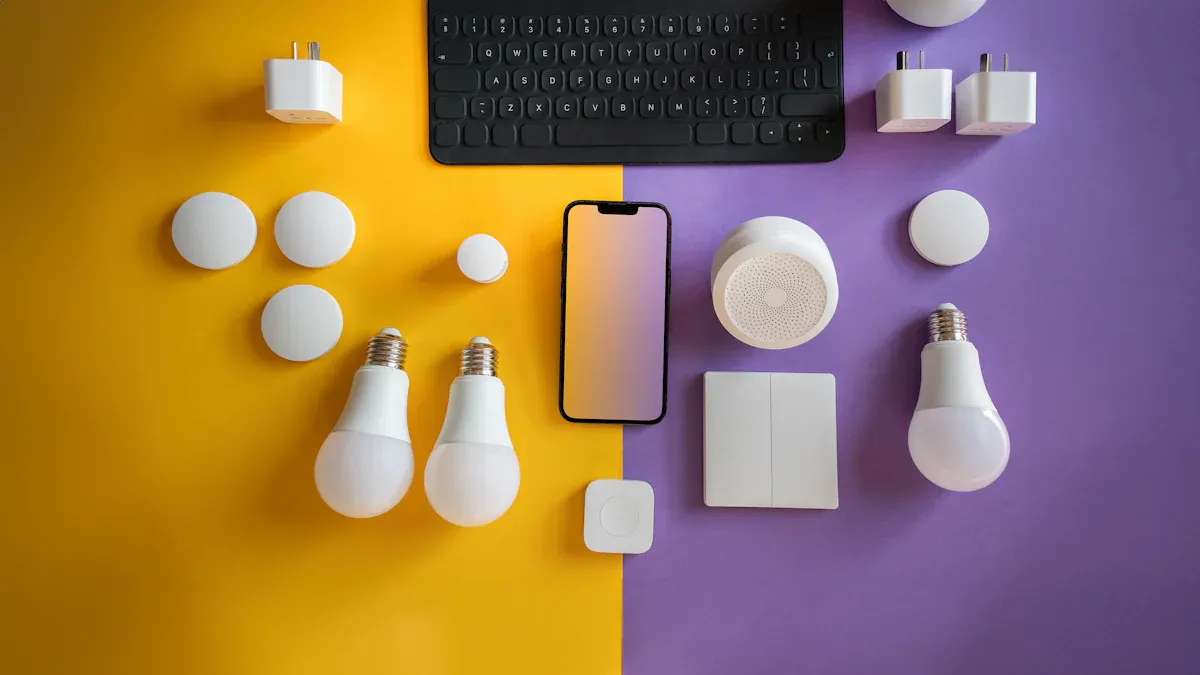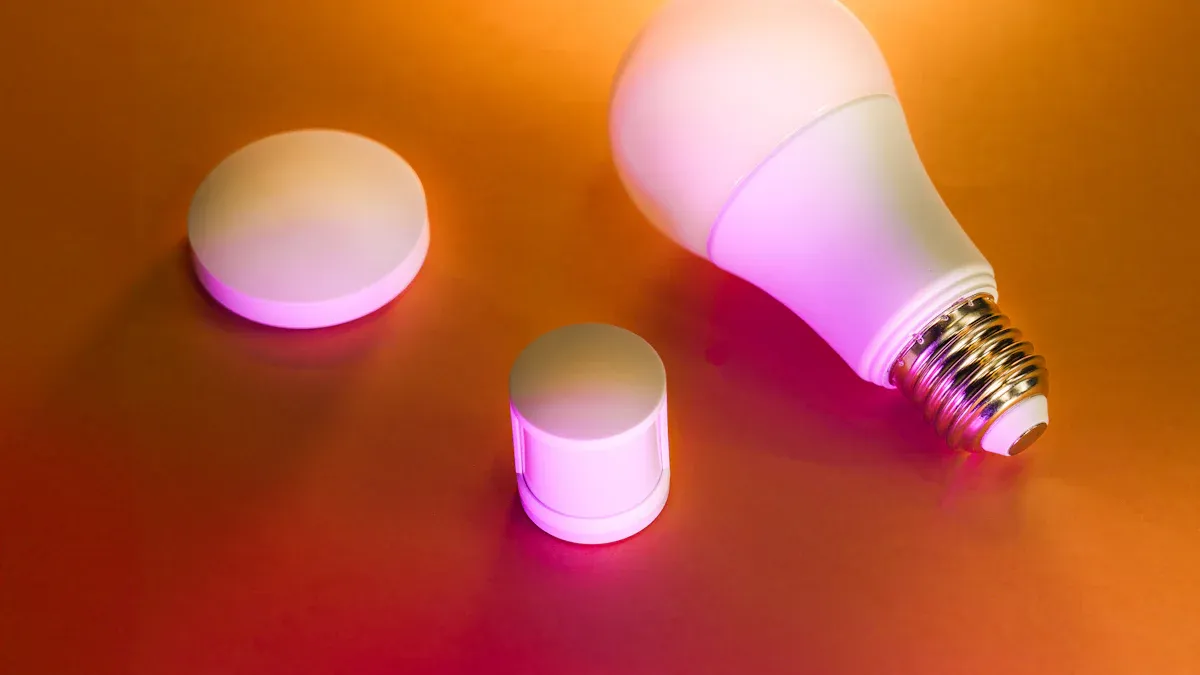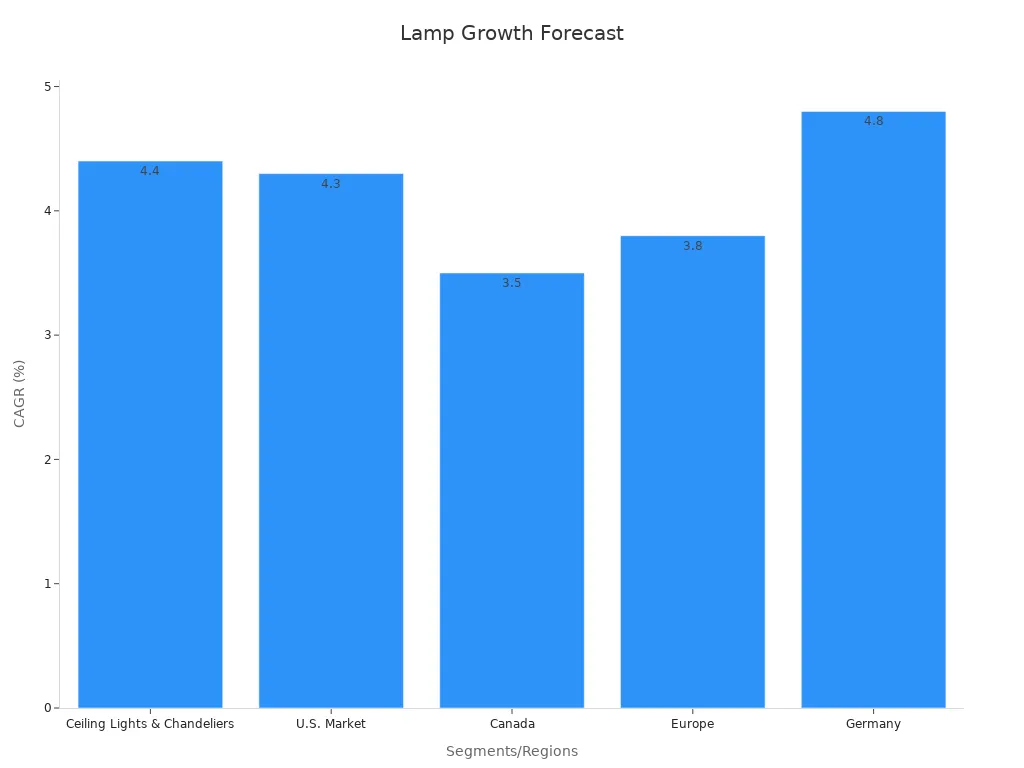Lamp Industry market trends, technologies, and future outlook

The lamp industry is changing a lot. LED and smart lighting are now the most popular trends. Many people see that light technology changes very fast. The smart lighting market was worth USD 15.05 billion in 2022. It may grow to USD 72.35 billion by 2030. Many people upgrade old lights with Led Light solutions. This helps the market grow. Light makers now care about saving energy, low prices, and the environment.
Metric/Aspect | Data/Trend |
|---|---|
Global smart lighting value | USD 15.05B (2022) |
Projected value by 2030 | USD 72.35B |
Hardware segment share (2020) | 56.9% |
These trends change how people pick lights for homes, products, and businesses. Companies that know About Us and new lamp industry news can keep up with what buyers want.
Key Takeaways
LED and smart lighting help the market grow by saving energy and adding new features. The lamp market is growing quickly around the world, especially in Asia Pacific and North America. People like modern lamps that save energy, have smart controls, and look nice. New LED and IoT technology make lights brighter, cost less, and allow smart lighting. Companies that use green tech, smart products, and fast-growing markets will be leaders in the future.
Lamp Industry Market
Market Drivers
The lamp industry keeps changing as new technology and what people want shape the market. Energy-saving technology is a big reason for this change. LED lighting has changed the lamp industry a lot. In 2013, LED lights made up only about 5% of the world’s market. By 2021, they made up over 50%. LED lights use less power and last longer. They also help lower carbon emissions. These things are what people and businesses want. They want to pay less for energy and help the environment.
Smart lighting features are also making more people want new lamps. Many people want lamps that work with smart home systems. These smart lamps make life easier and let you control the light better. Government rules and rebate programs, especially in North America, help people use energy-saving lights. For example, in 2020, 47% of homes in the U.S. used LED lights inside. This shows people are quick to use new lighting technology.
Sustainability is very important for the market to grow. Companies try to make products that use less energy and last longer. They also try to cut down on waste and use materials that are better for the earth. These actions help companies follow rules and give people what they want.
Market Size and Growth
The lamp industry around the world keeps getting bigger. In 2024, the market was worth about USD 15 billion. Experts think it will reach almost USD 24 billion by 2033. The market is expected to grow about 5.3% each year from 2025 to 2033. This growth comes from more people using LED lights, smart lighting, and more people living in cities.
Here are some important facts from recent data:
Metric | Value |
|---|---|
Market Revenue in 2022 | USD 13.53 Billion |
Market Revenue Forecast in 2030 | USD 19.69 Billion |
CAGR (2023-2030) | 4.8% |
Largest Segment (2022) | Desk Lamp |
Fastest Growing Segment | Floor Lamp |
Largest Regional Market (2022) | Asia Pacific |
Fastest Growing Country Market | U.S. |
The market is also helped by people having more money to spend and good government rules. New ideas like smart home lighting and lamps that do more than one thing show what buyers want. These trends help the market grow and make companies compete more.
Regional Dynamics
Looking at different areas, Asia Pacific is the biggest lamp market. North America, Europe, and Asia Pacific all help shape the market. North America is known for using energy-saving lights and smart home tech quickly. People there like LED lights because they last long and save energy. They also care about how lamps look, which affects what they buy.
More people moving to cities and new buildings in Asia Pacific increase the need for good lighting. The large number of people and growing cities in this area mean more lamps are needed. Europe helps the market grow by having strict rules for saving energy and caring for the environment.
Note: There is a lot of competition between regions. Companies in each place work hard to make new products and meet local needs. This competition helps the lamp industry get better and use new technology faster.
The lamp industry keeps changing to match global trends in saving energy, being green, and using smart technology. Watching what drives the market and how regions change helps companies stay ahead.
Table Lamps Market Trends

Consumer Preferences
People want more than just a lamp for light. Many now pick lamps with LED light sources. These lights save energy and last a long time. Buyers also like smart features, like dimming and wireless control. Modern and simple designs are very popular. People want lamps that fit their home style. Metal, glass, and ceramic are top choices for materials. Some people like wood for a natural look. More people want lamps that show their own style. Home décor trends and working from home make people need better lighting. Buying lamps online is now much easier.
Aspect | Consumer Preference / Trend |
|---|---|
Design Styles | Modern, contemporary, transitional, and niche styles |
Materials | Metal, glass, ceramic, wood, and others |
Light Sources | LED (energy-efficient, smart features), incandescent (niche), others declining |
Technology | LED adoption, smart features, wireless control |
Segment Growth
The table lamps market is growing in many areas. Decorative lamps made up 62.7% of the market in 2023. The commercial segment earned the most, but home lamps are growing fast. Experts think home lamps will grow by 5.7% each year. In 2023, the global table lamps market was worth USD 18.74 billion. It may grow by 9.5% each year from 2024 to 2030. LED technology helps this growth a lot. Companies like Philips and OSRAM lead with new light ideas. Online sales and new products also help the market grow.
Note: Studying the table lamps market helps companies find new chances. Looking at type, use, and region helps make better plans.
North America Table Lamps Market
North America is important for the table lamps market. In 2018, LED table lamps made USD 1,268.1 million. By 2025, this could reach USD 3,395.6 million. The market grows by 15.1% each year from 2019 to 2025. In 2018, North America made up 25.5% of global LED table lamp sales. The U.S. leads because of more cities and home updates. Canada also wants more energy-saving lights. In 2024, North America made USD 2.5 billion from table lamps. By 2033, this could be USD 3.8 billion, growing by 5.2% each year from 2026 to 2033. Smart lighting and LED lights help this growth. Most buyers want smart and energy-saving lamps for their homes.
Metric | Value (USD Million) | Timeframe |
|---|---|---|
Revenue (LED Table Lamps) | 1,268.1 | 2018 |
Projected Revenue | 3,395.6 | 2025 |
Market Revenue (North America) | 2,500.0 | 2024 |
Projected Market Revenue | 3,800.0 | 2033 |
CAGR | 5.2% | 2026 to 2033 |
North America’s table lamps market keeps growing. People want smart, stylish, and energy-saving lamps. Companies work on LED and smart features to meet what buyers want.
Tech Innovations

LED Advancements
LED technology has changed the light industry a lot. In recent years, LEDs got better, cheaper, and work longer. White LEDs can now reach up to 220 lumens per watt. Old incandescent bulbs only had 18 lumens per watt. This means LEDs are much brighter and use less energy. The table below shows some big changes:
Metric | Value / Change | Timeframe | Notes |
|---|---|---|---|
Luminous efficacy of white LEDs | Up to 220 lm/W | 2020s | 12x higher than incandescent bulbs |
Overall lamp efficiency (warm white LEDs) | 5.8% → 38.8% | 2003-2020 | Major efficiency gains |
Manufacturing cost of white LEDs | $1.11 → $0.05 per unit | 2003-2020 | 95.5% cost reduction |
Rate of technological progress | Faster than legacy | Since 1996 | Driven by R&D and innovation |
LEDs now use about 75% less energy than old bulbs. They can last up to 50,000 hours. That is 25 times longer than older lights. These changes help people and businesses save money and energy. There are still some problems, like heat and color quality. But scientists keep working to make LEDs even better.
Smart Lighting
Smart lighting is now a big trend in the lamp industry. Many homes and businesses use smart products to control lights. People can use their phones or voices to change light settings. Smart bulbs are popular because they are easy and not too expensive. More new buildings use fixtures with smart features.
Most sales still happen in stores, making up over 65% of money earned.
Online sales are growing fast, at 8.5% each year, because there are more choices and better prices.
Homes make up over 42% of sales, thanks to smart home products and IoT-enabled lighting.
Smart lighting helps people save energy and make their spaces special. Many offices and cities use smart lighting to save money and have better control.
IoT Integration
IoT integration has changed how people use and control lights. Smart lighting systems that adapt can save up to 35% more energy. In Barcelona, smart lighting saves $37 million each year and made 47,000 jobs. About 66% of U.S. cities spend money on IoT for smart city projects, including lighting.
Metric Description | Numerical Value | Context/Impact |
|---|---|---|
Savings from adaptive smart lighting systems | 35% | Efficiency gain |
Annual savings in Barcelona from intelligent lighting | $37 million | Financial impact |
Job creation in Barcelona due to intelligent lighting | 47,000 jobs | Economic growth |
US cities investing in IoT for smart cities | 66% | Includes lighting and sensors |
Reduction in street lighting expenses via smart lighting | 30% | Cost savings |
IoT lighting lets people use features like motion sensors and remote control. These systems help cities and businesses save money and keep people safe. As more people buy smart home products, IoT will keep changing how we use lights.
Outlook
Future Growth
The lamp industry will likely grow a lot in the future. The global LED lighting market could reach about USD 134.71 billion by 2030. This is because more people want energy-saving lights. Cities are growing fast, and smart city projects are getting bigger. The commercial segment is the biggest part of the market. In 2024, it had over 51% of the market. Offices and malls need more LED troffers and downlights. New technology and knowing about energy savings help this growth.
Segment / Region | Market Value (2023) | Projected Market Value (2030) | CAGR (2024-2030) | Additional Notes |
|---|---|---|---|---|
LED Table Lamps (Global) | USD 515 million | USD 799.2 million | 6.7% | Overall market growth |
Residential Segment | N/A | N/A | 10.5% | Driven by energy-efficient lighting adoption |
Commercial Segment | USD 1.2 billion | N/A | 11.2% | Corporate sustainability goals driving adoption |
Educational Institutions | N/A | N/A | 12% | Focus on sustainable infrastructure |
Smart LED Table Lamps | USD 500 million | USD 1.5 billion | 15.8% | Integration with smart home technology |
North America (Market Share) | 40% (Residential) | N/A | N/A | Leading region in residential and commercial segments |
Europe (Market Share) | 35% (Residential) | N/A | N/A | Significant contributions from Germany, UK, France |
Asia-Pacific (Growth Rate) | N/A | N/A | 12.7% (Residential), 13.5% (Commercial), 14.1% (Educational) | Fastest growing region driven by urbanization and government initiatives |
The whole lamps and lighting market is worth USD 83.6 billion in 2024. Experts think it will keep growing at over 4.2% each year until 2034. Ceiling lights and chandeliers make up about USD 41 billion. They are growing at 4.4%. The U.S. is the biggest market, worth USD 20.6 billion. Smart lighting and home updates help this growth. Asia Pacific is growing very fast. It has 34% of the global smart LED market. IoT and smart buildings help this area grow.

The table lamps market looks good, especially for smart LED table lamps. These could be worth three times more by 2030. The residential segment will grow the fastest. People want energy-saving and smart lights for their homes. The commercial and educational markets also look strong. Sustainability and smart features make people invest more.
The future for the lamp industry looks bright. LED and smart technology lead the way. Global trends in green cities help too.
Challenges Ahead
Even with good growth, the lamp industry has problems. High starting costs make it hard for new or small companies. There are not enough skilled workers to keep up with new tech. Strict rules about energy and the environment raise costs.
Tariff wars and other world issues hurt supply chains and scare investors.
Companies face more problems as they grow and use new tech.
Big companies like Signify and OSRAM GmbH compete hard for buyers.
Changing rules and trade fights make planning for the future tough.
From 2021 to 2024, company profits and market shares changed a lot. Reports use charts and tables to show how these problems affect growth and competition.
Note: The lamp industry must solve these problems to keep growing and reach its goals.
Strategic Moves
Industry leaders can do many things to stay strong:
Invest in LED and Smart Technologies
Companies should spend money on research for LED and smart lighting. These products are popular and save energy.Expand into Fast-Growing Regions
Asia Pacific is growing the fastest. Companies should work with local partners and make products for these markets.Focus on Sustainability and Smart City Infrastructure
Green cities and smart projects give new chances. Companies that help these projects can get more buyers.Strengthen Supply Chains
Strong supply chains help companies deal with world events and rule changes.Enhance Product Differentiation
Special designs and cool features help brands stand out. Companies must keep making new things to win.Monitor Regulatory Trends
Knowing about new rules helps companies enter markets and avoid problems.
Tip: Companies that change fast and invest in smart, green products will lead the market and shape the future.
The lamp industry’s future looks good, with growth in all areas. By solving problems and making smart choices, companies can do well in a busy and changing market.
The lamp industry is always changing. LED, smart lighting, and IoT are the main trends. Companies that learn fast can do better than others.
The Bureau of Labor Statistics and other groups watch how new technology is used. They also look at research and how jobs change. This gives companies good facts to help them make choices.
Industry leaders should spend money on new ideas. They need to watch the market and use research to find new chances. Keeping up with trends and new tech helps companies do well for a long time.
FAQ
What are the main drivers of growth in the lamp industry?
People want lights that save energy and have smart features. LED technology, sustainability, and smart home products are important. Companies work hard to make new and better products. They try to be more efficient to stay ahead of others.
How does smart technology impact the table lamps market outlook?
Smart technology lets people control lamps without wires. It works with smart home products. This makes more people want these lamps. The future for table lamps looks good because of this. Buyers like lamps with smart features and ones that save energy.
Why is North America important in the table lamps market analysis?
North America uses energy-saving lights and smart features first. People there want smart home products and green cities. This helps the market grow fast. North America also starts new trends in lamp design and technology.
What role does sustainability play in the lamp industry?
Sustainability changes how lamps are made and sold. Companies use eco-friendly materials and make energy-saving outdoor lights. These actions help cities grow in a green way. People want green products, so companies make more of them.
How does competition affect the future outlook of the lamp industry?
Competition makes companies create new and better products. They spend money on new technology and smart city projects. This means better lamps, lower prices, and a good future for the lamp industry.
See Also
Advancements And Trends In The Evolution Of LED Streetlights
Comprehensive Overview Of Electric Lamp Types And Their Uses
Understanding LED Bulbs: Technology Benefits And Choosing Advice
Efficient Industrial LED Bulbs: Applications And Selection Guide

